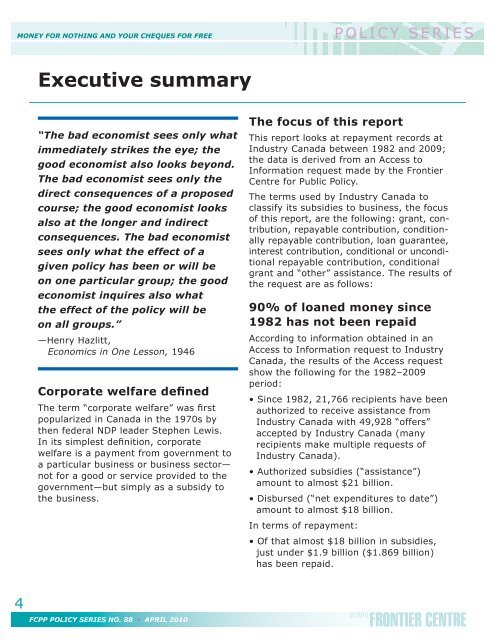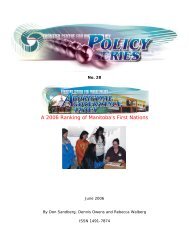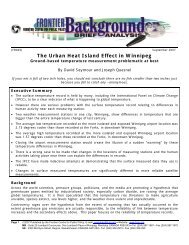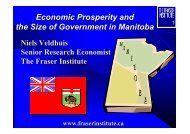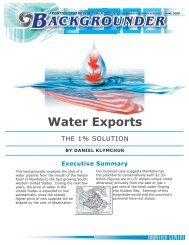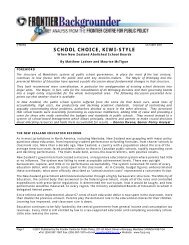View entire study as PDF - Frontier Centre for Public Policy
You also want an ePaper? Increase the reach of your titles
YUMPU automatically turns print PDFs into web optimized ePapers that Google loves.
MONEY FOR NOTHING AND YOUR CHEQUES FOR FREE<br />
P O L I C Y S E R I E S<br />
Executive summary<br />
“The bad economist sees only what<br />
immediately strikes the eye; the<br />
good economist also looks beyond.<br />
The bad economist sees only the<br />
direct consequences of a proposed<br />
course; the good economist looks<br />
also at the longer and indirect<br />
consequences. The bad economist<br />
sees only what the effect of a<br />
given policy h<strong>as</strong> been or will be<br />
on one particular group; the good<br />
economist inquires also what<br />
the effect of the policy will be<br />
on all groups.”<br />
—Henry Hazlitt,<br />
Economics in One Lesson, 1946<br />
Corporate welfare defined<br />
The term “corporate welfare” w<strong>as</strong> first<br />
popularized in Canada in the 1970s by<br />
then federal NDP leader Stephen Lewis.<br />
In its simplest definition, corporate<br />
welfare is a payment from government to<br />
a particular business or business sector—<br />
not <strong>for</strong> a good or service provided to the<br />
government—but simply <strong>as</strong> a subsidy to<br />
the business.<br />
The focus of this report<br />
This report looks at repayment records at<br />
Industry Canada between 1982 and 2009;<br />
the data is derived from an Access to<br />
In<strong>for</strong>mation request made by the <strong>Frontier</strong><br />
<strong>Centre</strong> <strong>for</strong> <strong>Public</strong> <strong>Policy</strong>.<br />
The terms used by Industry Canada to<br />
cl<strong>as</strong>sify its subsidies to business, the focus<br />
of this report, are the following: grant, contribution,<br />
repayable contribution, conditionally<br />
repayable contribution, loan guarantee,<br />
interest contribution, conditional or unconditional<br />
repayable contribution, conditional<br />
grant and “other” <strong>as</strong>sistance. The results of<br />
the request are <strong>as</strong> follows:<br />
90% of loaned money since<br />
1982 h<strong>as</strong> not been repaid<br />
According to in<strong>for</strong>mation obtained in an<br />
Access to In<strong>for</strong>mation request to Industry<br />
Canada, the results of the Access request<br />
show the following <strong>for</strong> the 1982–2009<br />
period:<br />
• Since 1982, 21,766 recipients have been<br />
authorized to receive <strong>as</strong>sistance from<br />
Industry Canada with 49,928 “offers”<br />
accepted by Industry Canada (many<br />
recipients make multiple requests of<br />
Industry Canada).<br />
• Authorized subsidies (“<strong>as</strong>sistance”)<br />
amount to almost $21 billion.<br />
• Disbursed (“net expenditures to date”)<br />
amount to almost $18 billion.<br />
In terms of repayment:<br />
• Of that almost $18 billion in subsidies,<br />
just under $1.9 billion ($1.869 billion)<br />
h<strong>as</strong> been repaid.<br />
4<br />
FCPP POLICY SERIES NO. 88 • APRIL 2010<br />
© 2010<br />
FRONTIER CENTRE


